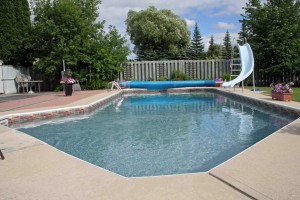
1. Sanitizers:
Common trade names: Chlorine, Bromine, Sodium hyprchlorite (liquid chlorine). Sanitizers are chemicals that are used to kill micro-organisms in the pool like bacteria, viruses, algae, amoeba, e.t.c There are several types of sanitizers, but the most commonly used is chlorine. Chlorine is popularly used because of its efficacy in killing contaminants and its affordability. Chlorine upon being applied to the pool water will produce hydrochloric acid by reaction with the water. This hydrochloric acid is able to penetrate the cell walls of all kinds of harmful micro-organisms and kill them in the process. There are two ways in which chlorine can be used to control microbial activities. One of them is to use it as an ongoing control where in the chlorine is applied regularly in small and moderate quantities. On the otherhand, chlorine is popularly used for pool shock treatments. Chlorine shocking treatments is the raising of the chlorine levels of water ten times the ordinary requirements. Chlorine shocking occurs when there is a dire need for an extra santization, for instance, when growth of algae is very visible and the water is practically green. Chlorine effectiveness drops as stabilizer rises.
2. Algaecide:
Algaecides are chemicals specifically created to control the growth of Algae in the swimming pool. Most often than not, the growth of algae is caused by lack of proper circulation of water. The algae scourge is so common that even properly maintained pools do experience algae growth. This is because algae spores can be blown into a swimming pool by wind or by swimmers. Once your pool is contaminated with algae, they start to grow and expand. If proper care is not taken, your pool water will completely change color and algae can also clog the pool filter. This is why Algaecides are recommended for frequent use in the pool. Swimming pool algaecide usually produces a hundred percent result within 24 hours of its use. Consistent use of algaecides will ensure that your pool never becomes so bad that you would need a shocking treatment.
3. PH Control:
PH measures the degree of acidity and alkalinity of your pool. The PH scale uses a measurement of between 1-14 Whereby when your pool water reads between 7.2-7.8, it indicates that your pool PH is neutral. PH control chemicals are designed to either increase or decrease the PH of your pool depending on how the PH currently reads. Sodium Carbonate and Soda Ash are popular chemicals used to increase the PH of pool water. Both chemicals are most commonly found in powder form but also available in liquid. On the otherhand, Sodium Bisulfate, and muriatic acid is used to lower the PH of your pool water. Chlorine looses effectiveness as the ph rises.
4. Oxidizers:
Oxidizers are chemicals that are used to burn up organics in the swimming pool. Organics like body oil, tan oil, skin sweat, skin cells are burnt up using oxidizing chemicals. The importance of oxidizers is that they help to clear the water and ensure that the pool is clean. When chemical oxidization takes place, they produce nitrogen and carbon dioxide gases. Monopersulfate is a commonly used oxidizer that produces an instant reaction. Sodium di-chor is another oxidizing chemical. Ozone is a very powerful oxidizer.
5. Clarifier:
Pool clarifiers are chemicals that act as coagulants on particles in the water so that the particles solidify and can be removed by filter. When your swimming pool water becomes cloudy or unsightly, a pool clarifier can come to your rescue. Adding a clarifying chemical ensures that these impurities making your pool unsightly can be easily filtered out. There are several types of pool clarifiers, the most common type being the polydadmac. The polydadmac is an ammonium chloride with a very high positive charge density. Another commonly used clarifier is the Chitosan.
6. Stabilizer:
Stabilizers help other useful chemicals. Take for instance, if you apply chlorine to your pool as a sanitizing agent during the day and the sun comes up, in a matter of hours, the chlorine will be rendered practically useless by the heat from the sun. This is where stabilizers come in. A popular stabilizing chemical is the Cyanuric acid. It is very effective in protecting chlorine. Stabilizing chemicals ensure that other chemicals function appropriately in your pool.
